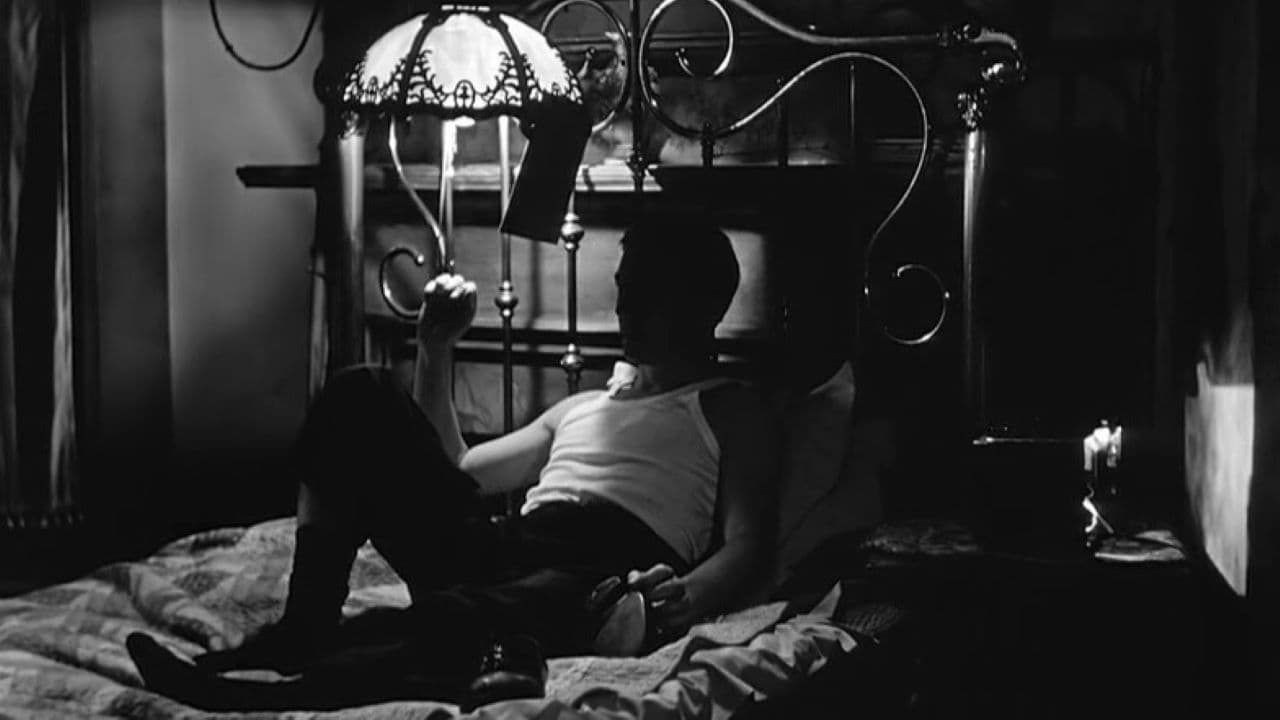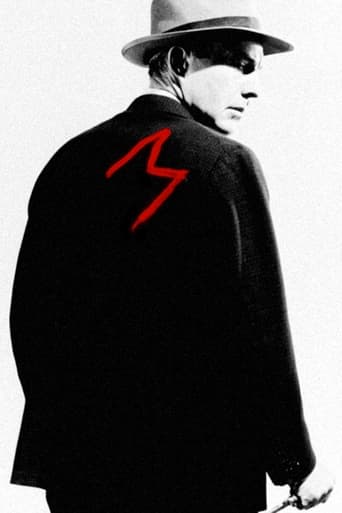

M (1951) *** (out of 4)A child killer is stalking the streets and soon the police are everywhere trying to catch him. This means that the police are stalking the low-life criminals and the crime bosses grow tired of it because it's costing them business. In order to get their business back, the crime bosses set out to catch the killer.Fritz Lang's 1931 film M is without question one of the greatest and most disturbing movies ever made. This 1951 remake from Joseph Losey went decades without being seen but a recent restoration has it available for fans to finally catch. Is it a worthy remake? It absolutely is a winning gem. Some people have called it a film noir but I really don't agree with that. The film is very much like the original in that it has you who the real monsters are out in the world.This film really shocked me on a couple levels. For starters, this was made in 1951 and I was shocked at how suggestive the material was. The early scenes show the killer stalking various little girls of all ages and race. The film certainly puts it in your face that this is a pervert and it doesn't shy away from this guy being attracted to them. Unlike the first film this one tries to explain why the killer is this way and of course it's the hatred of his mother.The cinematography is a major plus and there's no question that Losey has great control of everything going on. There's a very long sequence inside a shopping center where the criminals are searching for the killer and the way this sequence is edited was just flawlessly done. Another major plus were the performances with everyone from a large role to a small one doing a great job. David Wayne plays the killer and brings a certain coldness to the role as well as a creepy undertone.M has been forgotten over the years due to it being unavailable but now that it's making the rounds I can't help but think that it's reputation is going to improve. It's certainly not on the same level as the Lang film but it's still quite impressive.
... View MoreIn the original version of "M" made in 1931, as well as in the remake of 1951, a city is plagued by a man who is killing children. The police become so relentless in their pursuit of the killer that the ordinary way of life of the criminal underclass becomes disrupted. As a result, the criminals take matters into their own hands, capture the child killer, and have a trial of sorts, during which he tells everyone that he is compulsively driven to do what he does. Before the mob can do anything to him, the police show up and take him away.In the 1931 movie, it is never explicitly stated that the children are sexually molested, but it is implied, and in any event, we would automatically assume as much anyway. In the remake, however, the movie goes out of its way to make it clear that the children are not molested. While a crowd watches the chief of police on television warning parents about the child killer, someone in the crowd asks, "What's he mean the children were neither violated nor outraged?" Someone else in the crowd responds, "What's the difference? He killed them, didn't he?"Well, it may not make any difference to the people in the crowd, but apparently it must have made a difference to the Production Code Administration. It was not sufficient merely to omit all reference to sexual molestation. It had to be explicitly denied. At the same time, all of the killer's victims are little girls, which would indicate a sexual preference. Presumably, just in case the audience refused to believe sex was not involved, the producers went the extra step to avoid any hint of homosexuality. The killer takes the shoes of his victims, which suggests a fetish, which in turn suggests a sexual perversion. Furthermore, in one scene, a man and wife are informed that their child has been a victim. As they start to leave, the woman turns around in desperation and says that maybe it is a mistake, that the child is someone else's. We can only conclude from this that there was no body in the morgue for them to identify, that the police were only going by the doll and the girl's dress, which are on the chief's desk. He holds up the dress for her to look at, which she recognizes as belonging to her daughter. From this we can only conclude one thing: the killer took off the girl's clothes, and her naked body is yet to be found. Still, we are supposed to believe that sex is not the motive for these murders. Censorship can be confusing.It goes without saying that the original was much better, and one way in which it was better is that the killer simply had an evil impulse that he did not understand. In the remake, owing to the popularity of psychoanalysis at the time, we are given an explanation for the killer's behavior as resulting from something that happened when he was a child. As a harbinger of that explanation, we see him strangling a clay model of a child, with a picture of his elderly mother sitting right beside him, almost as if she were watching him do it. At the end, when the child killer is surrounded by the underworld figures that captured him, he gives a garbled explanation about how his father mistreated his mother, and how she raised him to believe that all men are evil. As a result, he reasons that since he is a man, then he is evil and deserves punishment. So, he has to kill little girls, partly to keep them from growing up and being mistreated by evil men, and partly so he will get caught and get the punishment he deserves. The explanation comes across as artificial, unsatisfying, and unbelievable. Fortunately, we are not told why he took the girls' shoes, which would only have made the explanation even more tortured. The remake was destined to be inferior to the original, but it would still have been a lot better movie had all that psychobabble at the end been left out.
... View More"M" is a remake of the Fritz Lang film shot twenty years earlier. In this version, the setting is Los Angeles, where the public is up at arms about a child killer on the loose.The first half of the film feels like a public service announcement for parents, warning them to protect their children from strangers. It's not a dramatic start, and the weaknesses easily shine through--the uneven acting, the contrived script, the repetitive exposition.Still, the film has interest as a document of its time--with its perhaps unintended swipes at the unprofessionalism of police, and the current views of crime and big city life. It also captures the nascent views of basic criminal psychology, much as some Hitchcock films do.The latter half of the film is about the actual apprehension of the murderer. There's a chase, which gives the film more interest, then a final denouement that examines common views of morality and opposing views of the nature/nurture dichotomy. If only the two halves were more cohesive.There is a lot going on in the film, and the cast offers many moments of surprising recognition. I recommend that viewers watch it, but I cannot assign a higher grade.
... View More***SPOILERS*** Excellent English language re-make of the 1931 German Fritz Lang crime classic "M" about a child murderer who's caught and tried by his own kind-criminals-for crimes that even they find beyond the pale. Martin Harrow, David Wayne, has been suffering from mantel illness since he was a child and now fully grown up, at age 35, those horrors of his childhood have come to manifest themselves to him as an a adult. Picking up school girls and offering them candy and ice cream Harrow ends up murdering them and mysteriously keeping their shoes as trophies of his crimes. With an all out dragnet by the L.A police to catch the child murderer it's the mob headed by crime kingpin Charlie Marshall, Martin Gabel, who puts out a contract on him; Not to whack him or rub him out but capture him and put him on trail from the crimes that he committed.Marshall feels in him bringing the child killer to justice it will take the heat of him and his crime syndicate by the LAPD headed by Chief Carney, Howard De Silva, and his hot handed assistant Lt. Becker, Steve Brodie, who seem to be totally helpless in capturing him. With the mob mobilizing all its resources they finally track Harrow down with his latest but still live victim 10 year old girl Janine Perreau at the deserted Bradbury Building in downtown L.A. Caught and brought to this mob run taxi garage Harrow is to learn his fate as Marshall's mouthpiece or high priced, with bottles of gin & scotch, shyster Daniel Langley, Luther Adler, acting as his public or mob picked defender.****SPOILERS**** Langley despite his severe alcoholism makes a brilliant defense of the what looked like doomed to die Harrow about his mantel illness that has controlled his actions during his six month murder spree. This is not what Marshall wanted in being put, together with his goons, in the same boat as Harrow who he feels he's an upright and law abiding citizen in comparison. With the helpless, from being beaten up by the mob, Harrow looking on his trial turns out to be not just against him but the person who had him captured and put on trial for murder the mob boss Charlie Marshall! With the police suddenly showing up and about to arrest,from his mob captors, Harrow Marshall lose it and with Langley exposing him and his mob's actions blows him away with the startled police being eyewitness to the murder looking on! Check out Marshall's top enforcer who does all the dirty work and heavy lifting, like breaking heads arms & legs, for him Pottsy played by a gorilla like Raymond Burr before he shed over 100 pounds and played a slimmed down looking Perry Mason on TV.
... View More